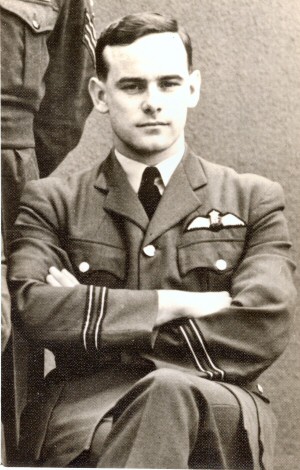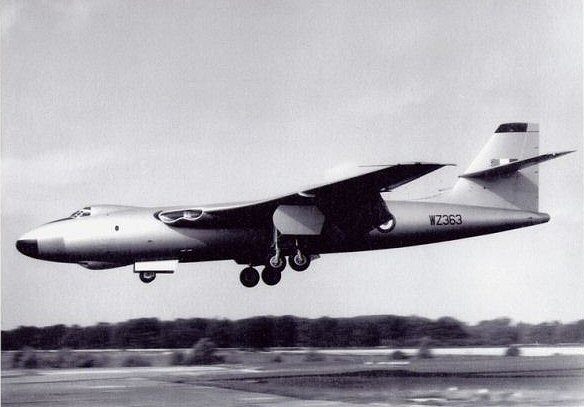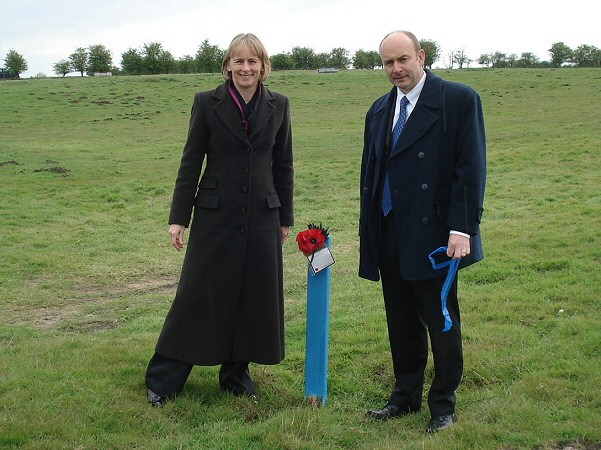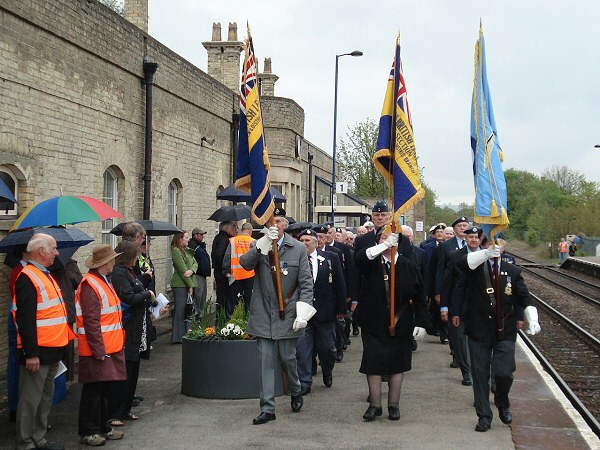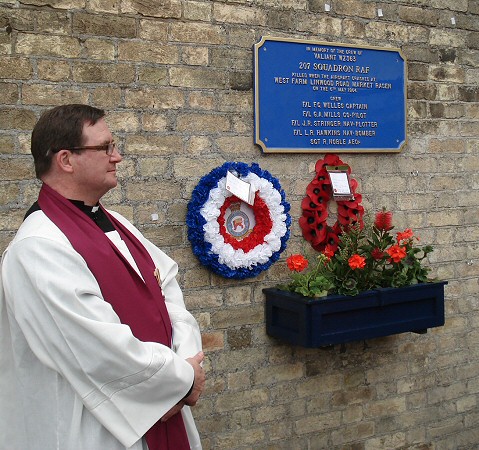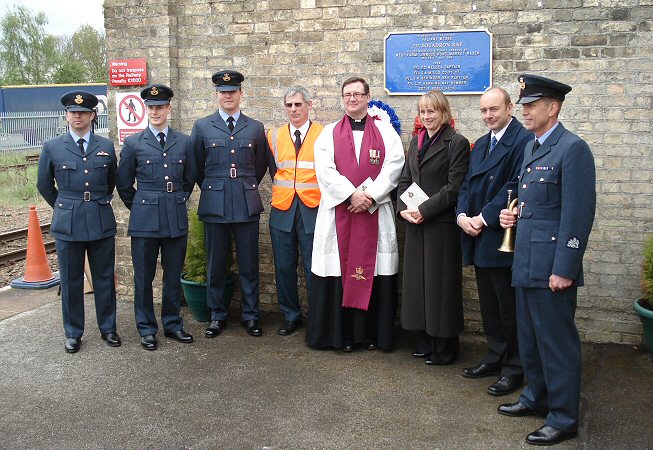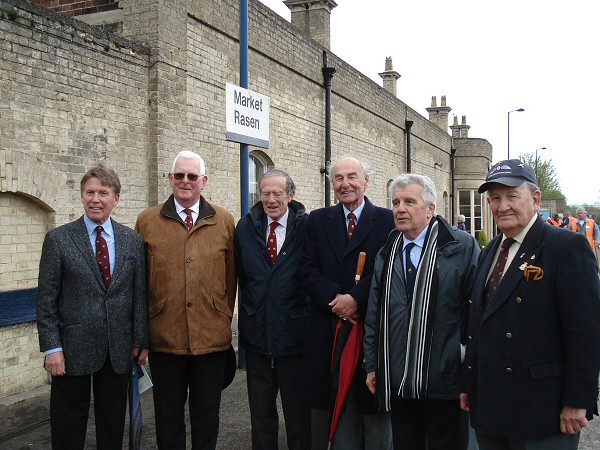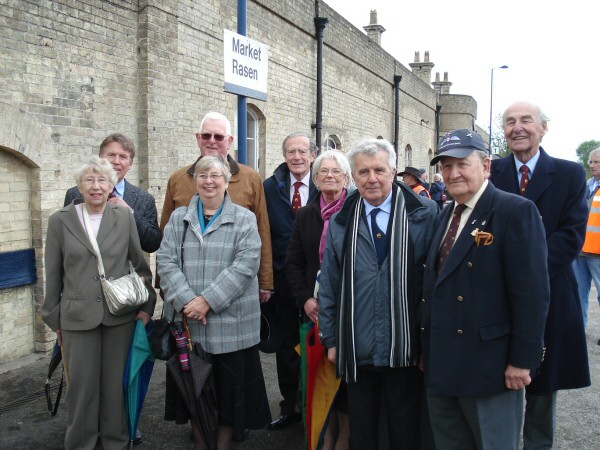The 207 Squadron crew of 49 Squadron Valiant WZ363 on 6th May 1964Captain: Flt Lt FC WellesChris Welles was posted in to 207 Squadron in September 1962 [source F449 Sep 1962] ORB February 1962: Sports and Entertainment: During the winter season Flight Lieutenant FC Welles, a captain on the Squadron, has captained both the Royal Air Force and combined Services Hockey sides. The weather has not been helpful but matches played so far have been for the RAF against the Indian Air Force and London University, and for the Combined Services against the Indian Air Force. Flight Lieutenant Welles has also represented Suffolk County at Hockey. 4 April 1963: The squadron six-a-side hockey team consisting of Flight Lieutenants FC Welles (captain), JK Davies, DR Jackson, MJ Gibbons, PA Ashmore and Flying Officer JR Potter won the 3 Group aircrew hockey competition by beating 15 Squadron 4 goals to nil. |
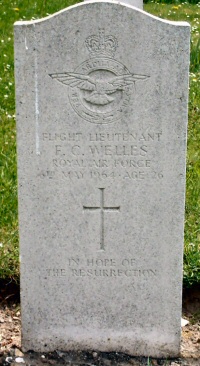 Marham Cemetery |
Co Pilot: Flt Lt GA Mills |
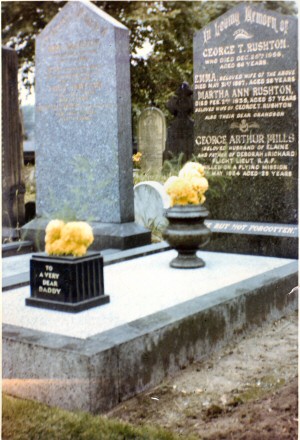 family grave,Warrington Cemetery. images source: his daughter Deborah |
Flt Lt GA Mills was not the usual co-pilot with this crew: he was posted in to 207 on 4 May 1962 as co-pilot in Flt Lt R Maclachlan's crew. The usual co-pilot was Plt Off KM Rae who was posted in to 207 on 7 Dec 1962 to join Flt Lt FC Welles' crew as co-pilot. See below for a web page about research by George Mills' son and daughter, with whom we have now made direct contact. Jock Wingate writes: George Mills was my regular
co-pilot and we last flew together on 5 May 1964, the day
before the accident. My regular crew at that time was: |
|
Nav Plotter: Flt Lt JR StringerPosted in from 232 OCU to crew 10 on 14 Feb 1964. He
replaced F/O AJ Armstrong. Dave Blackford (Nav Plotter 12/63-6/65): Just poking around on my computer and sadly came across the demise of Valiant WZ 363 on May 6 1964 which brought back sad memories. I am now in my mid 70s but still remember that occasion which very nearly included me, Flt. Lt. Dave Blackford as the Nav Plotter. It was what we called a gash flight when the aircraft became available after servicing, and in those days it was always about "getting hours in" for the Squadron. I was one of the few Navigators who was on the phone and we were always the easy ones to get hold of. I got a phone call telling me that I was required to make up a crew but I had an Anson aircraft booked for 0700hrs the following morning to fly me to Middleton St George to hand over our Dispersal Airfield inventory - so poor old Bob Stringer got lumbered (he also being on the phone). |
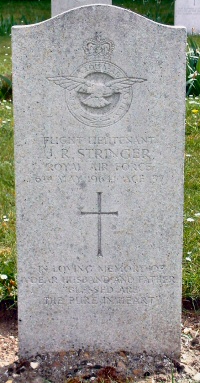 Marham Cemetery |
| I'd never seen the accident report before and I
can almost imagine those last awful, fateful moments with the
pilot and co pilot desperately trying to hold the nose of the
aircraft up - and as soon as they released the controls to
eject, the god almighty bunt would have caused massive
negative G. If I'd been on board I know that I would have told
them to roll the aircraft inverted to gain a few moments to
get out. Easier said than done perhaps!
I believe my Anson got used to fly to Binbrook and I never did to this day, hand over that Inventory. Very sad memories indeed. I flew as Nav Plotter with Flt Lt. Gwillam Price but I recall that it was around this time that the corrosion of the main spars was discovered, after one failing on final approach at Gaydon - fortunately with no loss of life. I also may recall talk on the Squadron as to whether WZ363 suffered some sort of failure - although the position of what was left of the tailplane jack might not back that up. As I say, just browsing one of my old Squadrons and coming across one of my several "near misses". They say "Only the good die young" so maybe that's why I'm still around. |
|
Nav Bomber: Flt Lt LR HawkinsPosted in to 207 on 27 Nov 1962 to be the Observer in Flt Lt FC Welles' crew. |
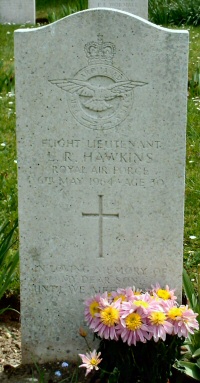 Marham Cemetery |
AEOp: Sgt R NoblePosted in, non-effective, for Flt Lt MW Carpenter's crew in Dec 1963: 21 Jan 1964 effectively joined the Squadron. His first listing in the Welles crew was on 18 Feb 1962 in XD818. F/O RW Moss, among others, was frequently listed in the Air Electronics role in the Welles crew listings. headstone photos: Raymond Glynne-Owen, who has offered to take better ones in due course |
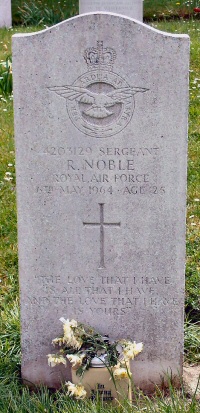 Marham Cemetery |
As a Wing Commander, the late AVM David Dick was OC 207 Squadron at the time of the accident.Information he passed on at the time the Roll of Honour was being researched stated that F/Lt GA Mills was a Technical Branch officer and a qualified co-pilot who was standing in for the regular co-pilot of the crew. It also stated that F/Lt Stringer was also from another crew (presumably crew 10, information is sought on the crew numbering). Here now is that report about the accident, from a 1965 issue of the quarterly Bomber Command Flight Safety Review. If anyone has an original copy (images are from a poor photocopy) please contact the editor. article source identified by Rob Owen, Official Historian 617 Sqn Association |
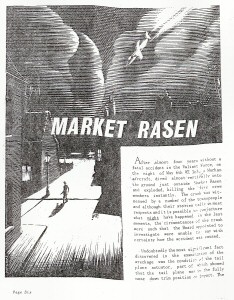 |
MARKET RASEN
"After almost four years without a fatal accident in the Valiant Force, on the night of May 6th WZ363, a Marham aircraft dived almost vertically into the ground just outside Market Rasen and exploded, killing the five crew members instantly. The crash was witnessed by a number of the townspeople and although their stories tally in most respects and it is possible to conjecture what might have happened in the last moments, the circumstances of the crash were such that the Board appointed to investigate were unable to say with certainty how the accident was caused.
Undoubtedly the most significant fact discovered in the examination of the wreckage was the condition of the tail plane actuator, part of which showed that the tail plane was in the fully nose down trim position on impact. The remains of the aircraft are now at Farnborough being pieced together in the famous 'accident hangar' in an attempt to discover further clues, but disintegration was so severe that there is only a slim chance that the investigators will be able to uncover vital information.
The crew who lost their lives in WZ 363 were Flight Lieutenant FC Welles, the captain, Flight Lieutenant GA Mills, a Technical Branch officer and a qualified co-pilot who was standing in for the regular co-pilot of the crew, Flight Lieutenants LR Hawkins and JR Stringer, the navigators and Sergeant R Noble, AEO. Flight Lieutenant Stringer was also from another crew. The flight was to consist of a high level navigational stage, low level bombing practice at Wainfleet, a practice PAN call using a diversion airfield and, finally, continuation training in the Marham circuit.
The weather experienced during the flight was not good, but well within the limits of the captain's green instrument rating and there was nothing to indicate that the trip was going other than uneventfully in the first four and a half hours.
When the practice PAN call was made, Preston centre chose Binbrook as a diversion airfield and the pilot made an excellent Ground Controlled Approach followed by a roller landing. The aircraft turned slightly right after rolling and the local controller watched it climb to about seven hundred feet before turning his attention to other aircraft on the airfield.
In the radar approach control room the controller had cleared the aircraft to turn on to a southerly heading for Marham, at the pilot's request, and moved from the precision approach screen to the search radar to monitor the aircraft clear of the area. At four and a half miles range the controller reported radar contact and received an acknowledgement from the pilot. He continued to track the aircraft to a range of six miles when contact was lost, not an unusual occurrence when the Moving Target Indicator facility is being used, as it was in this case. The controller was rather surprised that the aircraft had not turned south as he expected, but switched out MTI expecting to re-establish contact. This he was unable to do and also failed to get a reply to his repeated attempts to raise the pilot on WT.
Since there was no contact with the aircraft another controller went to a vacant search radar position to assist. There was no obvious indication of an aircraft, but as the controller scanned the tube he noticed an unusual return on the five mile ring. It resembled the sort of paint that a flock of birds might make and slowly increased in size and drifted downwind. At the same time the runway controller, on the airfield, noticed a flash on the horizon and shortly afterwards heard the muffled thump of an explosion.
In the town of Market Rasen and the surrounding countryside, the last moments of 363 must have been seen by dozens of people, despite the fact that it was nearly midnight, with a steady drizzle from a cloud base of about 1,200 feet. The Board recorded the evidence of seven civilian eye witnesses, all of whom saw the aircraft apparently blazing furiously as it passed over the centre of the town.
Mr Sharpe, who served as a Flight Engineer during the war years, was approximately one and a half miles away from the aircraft when he first saw it. 'It lit the surrounding countryside as light as day' he said, and added that it was brighter than any wartime flare he had seen. As he watched, the glare died away and the aircraft disappeared from his sight. Another witness, awakened by a rumble like thunder, jumped out of bed in time to see the aircraft as it flew past his window 'emitting dense clouds of smoke and two or three short bursts of sparks'. One housewife stated that the aircraft had a long tongue of flame coming from the rear of it and another, 'I looked into the street and saw balls of fire floating down towards the station'. As she watched, the aircraft, nose-diving, disappeared from view and a great column of fire and smoke shot up followed by the sound of an explosion.
From the time of the last R/T communication with 363 to the time of the crash on the southern edge of the town, a maximum of 69 seconds had elapsed - it could have been much less, but the Board found it impossible to make a more accurate estimation.
The aircraft struck the ground a few feet from a farm yard in an attitude approximately 70 degrees nose down, and with the left wing down, at a speed estimated to be somewhere between 200 and 300 knots. On impact, the aircraft slid twenty six feet to the right and the severe detonation which occurred made a crater over twenty feet deep, throwing flaming fuel and debris to a very considerably height, probably not less than a thousand feet.
Not only was the investigation made extremely difficult by the exceptional disintegration which took place, but it was further complicated by the spread of the wreckage which was taken downwind, along the final flight path of the aircraft. With so many eye witness reports of fire in the air the investigators were, naturally, looking for pieces of the aircraft which might have fallen off in flight and provided evidence as to the origin of the fire, but although countless pieces of aircraft structure were recovered - even as far as one and a half miles from the crash - not one showed any sign of the very characteristic, pre-crash burning expected.
Recovery of identifiable parts from the crater, was slow. It was continually filling with water and digging went on finally to a depth of thirty feet. However, although it was soon established that the aircraft went in 'clean', the initial difficulty in finding the No.4 turbine disc seemed to support the theory that an engine had disintegrated and caused control failure. Eventually, when the disc was found, deep in the crater, the examination by a Rolls Royce representative showed that not only had all engines suffered very similar damage, but that they were all under power at impact (revs. at least 7,000) and there was no sign that flame break-out had occurred on any of them.
This new evidence together with the absence of any aircraft parts showing signs of pre-crash burning seemed directly to oppose the many reports of eye witnesses. Although in their findings the Board consider that there is a strong possibility that the fire seen was the result of repeated attempts at re-lighting an engine, the detailed examination of the wreckage is still going on at Farnborough and the possibility of structural fire has not been ruled out.
The digging also produced evidence that no attempt had been made by any crew member to escape. Neither of the two ejector seats had been used, the canopy detonators had not been fired and the entrance door was found in the crater.
On the ninth day of the investigation, which had been going on at the scene of the crash, and elsewhere, from early morning until late at night, the tailplane incidence screwjack was recovered from the crater. It was found set in the position to give full nose-down trim to the aircraft. The belief that this was the position of the jack before impact was supported by the condition of the screw and the nut and confirmed by the remains of the limit switch actuator which showed that the limit switches for maximum travel were in the operating position.
No other evidence of obvious importance was produced from the wreckage and after having spent twenty two long days, without a break, on examining reports and making trials, the Board felt that nothing further could be done until the Farnborough investigation was complete. The Board's conclusions are made, therefore, in the knowledge that the cause of the crash has not been positively established and that, later, more evidence may be made available.
The Board considered many possibilities, some of which they were able to reject. For example the aircraft did not touch a ridge, 156 feet high two and a half miles west of the airfield. A test flight in the presence of a witness who heard 363, indicated that it would have cleared the ridge easily, even allowing for asymmetric flight and handling errors.
The R/T contact was good and Flight Lieutenant Welles sounded, on the tape recording, like a captain in complete control of a serviceable aircraft. This impression of well being is characteristic of all the R/T calls, including the last. The failure obviously came with almost no warning and developed to catastrophic proportions, a1l within the space of a period which was probably less than a minute. It may be that the failure of the captain to turn south, having announced his intention of doing so marked the first symptoms of the trouble which was to bring about the crash.
The evidence ruled out structural failure, but the possibility that control failure had occurred could not be excluded, although there was no supporting evidence that it had.
When considering the reports of fire in the air the Board were faced with a direct conflict of general evidence. It was singularly unfortunate, from the point of view of the investigation, that the wind had carried wreckage back along the track which the aircraft was known to have flown in its final trajectory. It was impossible to separate those parts of the aircraft which could have been lost in flight if a structural fire had taken place, from those deposited as a result of the explosion. However, none of the pieces found showed obvious signs of fire in the air.
One explanation which fitted the facts was that at the time that the aircraft was flying over the town the engines were being re-lit. If negative 'g' had been experienced during a bunt following a nose down movement of the tailplane the fuel pumps might have been uncovered. Once the recuperators became exhausted the flame out would occur, but with a reduction of negative 'g', the pumps would again pass fuel. It was thought that this fuel ignited during relighting attempts and gave the torching effect described by the witnesses.
Finally the pilots had exhausted their reserves of strength in holding the aircraft level against the forces of the tailplane in the extreme position and the release of the control column pitched the aircraft into the steep impact angle.
An examination of a wiring diagram showed that a TPI runaway could only occur as a result of two defects, one to apply current to the power side of the circuit and one to make a selection. All available defect reports of the TPI system failed to show one instance of a true runaway. However Special Occurrence Reports investigated over the last three years recorded one TPI reversal, a failure where the tailplane moves in one direction only, irrespective of the selection made.
Technical evidence showed that reversal could have been caused by any one of four single faults. In two of these cases changing the cockpit selections from Fine to Coarse or from lst to 2nd Pilot's selection would have made the tailplane fully operative. However if the fault had occurred at either of two other switches the tailplane would have moved in one direction only each time it was selected. In this case the only remedy would have been to stop trimming, it would not have been possible to move the tailplane back again.
The Board considered that at the point where TPI reversal might have occurred the aircraft would have been flying at 240 to 250 knots and that coarse trim would have been selected. A slight adjustment of trim could have resulted in an out of trim condition becoming worse. Although releasing the switches would have stopped the tailplane movement, the nose-down pitch could have resulted in the pilot instinctively continuing to trim nose-up. Any attempt to restore the trim using the co-pilot's switches would only have worsened the situation. In six seconds of application the tailplane would have moved to the fully nose down trim position.
If this had happened, and bearing in mind that it would have occurred at night, in cloud and with height rapidly reducing from four thousand feet, the pilots would have been extremely hard pressed to regain control, especially without the pitch-up force provided by the extension of the airbrakes.
Thus, the accident could have been caused by a defect in the TPI system followed by a crew drill error, but it must be remembered that it could equally as well have been the result of a double defect, similar to that described, or even brought on, perhaps, by a fire causing an electrical short circuit. In view of the possibility that there could have been major factors in the circumstances of the crash of which the Board had no knowledge they could be no more specific than state that the most likely cause of the accident was a TPI malfunction. There was no evidence of negligence of any description, either in servicing or in the operation of the aircraft.
On the recommendation of the Board one or two small but important changes have been made in crew drills and operating procedures. The use of the TPI coarse motor is now associated with airspeed and not the amount of movement likely to be required. Now, at speeds above 200 knots, fine control of the motor is to be selected in order to give the pilot more time to diagnose and correct an electrical fault should it occur. Other changes have been made in the methods of electrically checking the TPI system in the event of a suspected defect.
As in other accidents the Board regretted the lack of an accident recorder in the aircraft which would have filled in the vital gaps in the investigation. The provision of such recorders in service aircraft is recognised as a vital flight safety requirement, but the installation and operation is difficult and costly and the trials scheduled for the equipment in Transport Command aircraft have not yet begun."
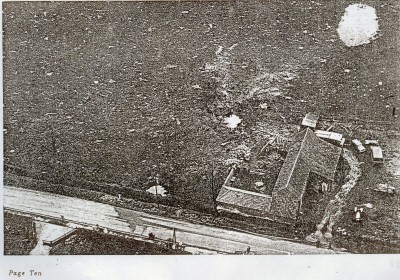
The crash site, from the above article
source: the late AVM David Dick, via R Glynne-Owen
6 May 1963 to 8 May 1963: summary - OPERATIONS/EXERCISES: [the Welles crew was one of those taking part in] Exercise MAYFLIGHT VI. This consisted of a dispersed flight to Cranwell and recovery under the direction of the Bomber Command Controller.
July 1963: The Welles crew was one of three taking part in Exercise ANCHOR.
October 1963: The Welles crew was one of three taking part in Exercise KINSMAN.
20 Dec to 23 Dec 1963: DETACHED CREWS: Flight Lieutenant FC Welles and crew carried out a Lone Ranger to EL ADEM LIBYA. On their return flight they were diverted to MANSTON because of bad weather, but returned to base later the same day.
3rd Feb to 7th Feb 1964: DETACHED CREWS: Flight Lieutenant FC Welles and Crew completed a Lone Ranger to LUQA, MALTA and successfully bombed on El Adem Range.
2nd to 5th March 1963: OPERATIONS/EXERCISES: The Welles crew was one of five taking part in Excercise KINSMAN. "The Squadron held a KINSMAN Exercise this month. This pre-planned exercise simply involves selected crews flying from the Squadron dispersal base. This allows personnel from the Squadron and the dispersal base to become familiarised with the operation of 'V' aircraft from their operational dispersals. This KINSMAN was of special importance in that it was the first to take place since the beginning to Centralised Servicing, and as the the Ground Crew were no longer Squadron personnel. The exercise was very successful and was concluded on the Thursday. The exercise also provided Technical Wing with a considerable amount of useful information to help them in standardising the ground requirements for future dispersal exercises."
On 16th March 1964, in XD857, the Welles crew recorded a DNCO "Manual trim tab indicator failed in the climb out."
On 30th April 1964, in WZ367, the Welles crew recorded a DPCO "No class. tgt."
